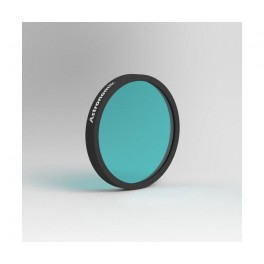 Ingrandisci
Ingrandisci Astronomik CLS Filter 31 mm, mounted
Astronomik
- Rimuovi questo prodotto dai miei preferiti
- Aggiungi questo prodotto ai miei preferiti.
- Stampa
 Ingrandisci
Ingrandisci Codice articolo: 8h00fi
An inexpensive filter that works against light pollution effects when viewing Deep-Sky objects with small telescopes.
![An inexpensive filter that works against light pollution effects when viewing Deep-Sky objects with small telescopes. [EN] An inexpensive filter that works against light pollution effects when viewing Deep-Sky objects with small telescopes. [EN]](https://www.teleskop-express.it/img/cms/Astronomik-8h00fi-CLS-Filter-31mm-ungefasst-1000.jpg)
♦ 94% transmission for H-beta and the two [O III] lines
♦ 97% at H-alpha
♦ Transmission ranges: 450 nm - 540 nm and longer than 650 nm
♦ Suitable for small telescopes and astrophotography
♦ Parfocal with other Astronomik filters
♦ Completely resistant against high humidity, scratches and aging effects
♦ Fine-optical polished glass
♦ 10 years warranty by the manufacturer
♦ Connection: round filter 31 mm, mounted
The Astronomik CLS is a budget filter for visual observation, Black & White photography and astro photographs of nebulae, galaxies and star clusters with astronomical instruments of any size.
The Astronomik CLS blocks the light of the spectral lines of mercury and sodium-vapor lamps and lets the largest part of the visible light and H-alpha emissions pass. All the important emission lines, as well as the spectral region that the very well dark adapted eye can see, can pass through the filter.
Main use:
The filters are optimized for use with aperture ratios from 1:3 to 1:15. Transmission losses and chromatic distortions, which are problems with other filters, only appear with Astronomik filters when extremely bright aperture ratios of 1:2 and more are used. The CLS filter is suitable for use with telescopes of all aperture sizes.
Alternative:
If photographically used with refractive optices (lenses involved), astro cameras and DSLR cameras without a built-in IR-blocking filter need the CCD version of the CLS filter.
Suitability:
♦ Visual observation (dark skies): Good, to reduce light pollution by mercury-vapour lamps (streetlight)
♦ Visual observation (urban skies): Good, an UHC-E or UHC filter is more suitable
♦ Film photography: Very good, colour balance is near perfect
♦ CCD and CMOS photography: Good, when used with an additional IR-blocking filter
♦ DSLR photography (original): Good, colour balance shifted but contrast enhanced
♦ DSLR photography (astro modified): Very good, colour balance is near perfect
♦ DSLR photography (MC modified): Good, when used with an additional IR-blocking filter
♦ Webcam / Video (Planets): Unsuitable
♦ Webcam / Video (Deep Sky): Very good, if light pollution is a problem
Technical Data:
♦ 94% transmission at 486 nm (H-beta)
♦ 94% transmission at 496 nm ([O III])
♦ 94% transmission at 501 nm ([O III])
♦ 97% transmission at 656 nm (H alpha)
♦ pass from 450 to 540 nm and beyond 650 nm
♦ Parfocal with other Astronomik filters
♦ Glass thickness: 1 mm
♦ Completely resistant against high humidity, scratches and aging effects
♦ Diffraction limited, the filter will not reduce the optical performance of your telescope!
♦ Astronomik filters are delivered in a high-quality, long lasting, filter box
Note on the protective ring:
Astronomik delivers the round filters from 31 mm diameter with a protective ring at the edge. The corresponding declarations of the manufacturer are available for download as PDF.
Filter transmission curve:![An inexpensive filter that works against light pollution effects when viewing Deep-Sky objects with small telescopes. [EN] An inexpensive filter that works against light pollution effects when viewing Deep-Sky objects with small telescopes. [EN]](https://www.teleskop-express.de/shop/Bilder/shop/astronomik-filter/astronomik-cls-kurve.jpg)
♦ The horizontal axis is the wavelength in nanometers (nm). 400 nm is deep blue, at 520 nm the human eye senses green and at 600 nm red. At 656 nm is the famous "H-Alpha" emission line of hydrogen.
♦ The transmission in % is plotted on the vertical axis.
♦ The red line shows the transmission of the filter.
♦ Visual filters: The grey line in the background shows the relative sensitivity of the human eye at night. The maximum is at ~510 nm and drops to longer and shorter wavelengths. You can easily see, that you can´t see anything of the H-alpha line at night (even if you can during daylight!) The sensitivity at 656 nm is 0% at night!
♦ Photographic filters: The grey line in the background shows the sensitivity of a typical astro camera sensor.
♦ The most important artifical emission lines are shown in orange. The artifical light pollution is dominated by see mercury (Hg) and sodium (Na), which are used in nearly all streetlights.
♦ The most important emission lines from nebulas are shown in green. The most important lines are from ionized hydrogen (H-alpha and H-beta) and double ionized oyxgen ([O III]). The square brackets indicate that these lines are forbidden.
Specifiche tecniche:
| Transmission for H-beta and the two [O III] lines: | 94% |
| Transmission for H-alpha: | 97% |
| Transmission ranges: | 450 nm - 540 nm and longer than 650 nm |
| Substrate: | Fine-optical polished glass |
| Anti-reflex coating: | Completely resistant against high humidity, scratches and aging effects |
| Filter thickness: | 1 mm |
| Parfocal: | with other Astronomik filters |
